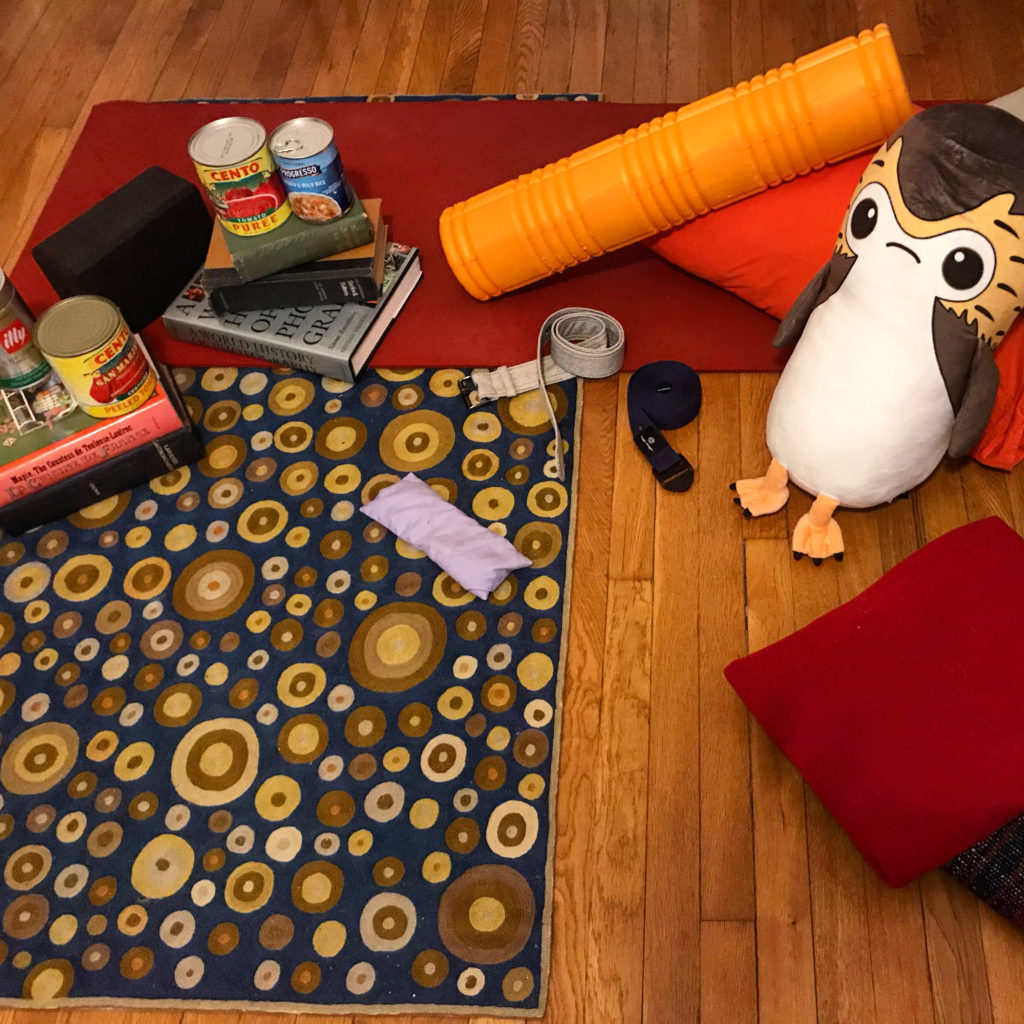You would not believe how many names I came up with for this entry. At one time I thought all the entries in this blog would be about props, so all the names were prop based. I’ll make you read them later. The best one was Prop Culture, but Disney owns it and this is definitely one of those times when picking another name was the better part of valor.

In most hatha vinyasa yoga traditions, including the very different practices of Iyengar and Ashtanga, props have meaning; maybe good (often good), maybe less positive. In some classrooms, or in some student or teacher minds, they’re a weakness, or simply “not yoga”. Or some props are ok and others aren’t, or some applications of proppage are valid others not. In more classrooms, props are there for those who need them, but they’re not necessarily part of the classplan. They may even be a sign not only of weakness, but of shirking the struggle of the practice.
In plenty of vinyasa oriented classes, props are integrated into the practice casually. Have a block around if you want it; one or two blankets if you need them. Oddly enough, one of the lesser focussed-on props, the strap, is the one that followers of The Struggle often allow for. On the other hand, teachers or studios may not even realize they’re applying stigma to the use of props.
Here’s the stigma. I don’t believe it’s generally intentional, but here it is: You’re here to learn to do these poses without help. Using help is a crutch. Either (a) all bodies can do this, and you’re just not trying hard enough or haven’t tried long enough, or (b) not all bodies can do this. Learn to be the outsider who needs help, or go home.
Clearly, there are plenty of rooms where props are integrated into vinyasa practice, and absolutely used in many other forms of yoga, e.g. chair yoga, restorative and of course yin, not to mention aerial and acro yoga, neither of which is considered a “soft” practice.
Most yin yoga teachers rely to a greater or lesser degree on props, and here’s why. Our physical focus is on allowing stress and tension to create resilience in connective tissue and bone—gather, collect that resilience with help from the nervous system, the mind, the subtle body and the heart. We rely on yin tissues and yin forces: gravity, physical assistance with props or by an experienced teacher.
Props allow us to place our bodies into positions that challenge our tissues for extended periods of time and maintain our coolth—our yin-ness.
In coming episodes of Propaganda, more about the props themselves, how we use them, DIY, and the funniest anti-prop screed I’ve ever read.
Here, btw, is the funniest anti-prop screed I’ve ever read! I guarantee you this was written by a man.
And here, drumroll, is the list of names for blogs about props:
Prop blog names
- Prop Culture (or Prop Coutour)
- Proper Tea
- My second favorite is All Prop-er Yoga Is Theft, but you have to know the Marxist Proper Tea joke
- Prop Up Class
- Prop up Event
- Prop up Store (or sale, and only if I start one of those boutiques where you sell Amazon stuff and get a slice of the action)
- Yoga done Properly, Proper Yoga, Yoga Proper.
- Hmmm. Proper-ly? or without the hyphen?
- Propaganda? Propaganza?
- Properties
- Prop Gap
- Propeteer
- Hip Prop Hooray
- Hop on Prop
- Prop It Like It’s Hot
- Prop Room
- It’s a Prop World After All
- Propular Mechanics*
- Prop School
- College Prop
- Proppin’ an’ Lockin’
- Prop, Drop and Roll**
- Mary Proppin’s***
- Prop the Magic Dragon***
*Walter Thompson
**myxyplyzyk
***Ben Slatkin
****Yellow
